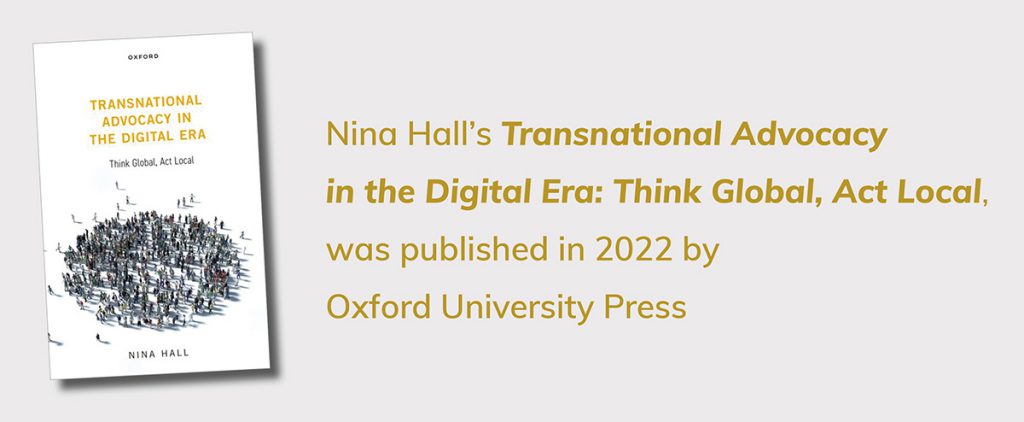Digital advocacy organisations have pioneered strategies to mobilise people rapidly, and shape public opinion. They now face challenges from new social media, and complex relationships with NGOs. Nina Hall and Paola Pierri outline five potential futures for these organisations
Digital advocacy organisations (DAOs), such as MoveOn, Campact, and GetUp can, in a matter of hours, launch online campaigns capable of mobilising millions of individuals. DAOs maintain frequent contact with their members via email and social media, and test their campaigns, using sophisticated digital analytics. Activists around the world have emulated this distinctive model of member-driven, multi-issue, rapid response, digitally-enabled campaigning.

Nina Hall’s recent book examines the global diffusion and power of such organisations. It notes that these groups are no longer pioneers in the advocacy sector, but are now challenged by the growth and strength of newer groups such as Fridays for Future and Sunrise. These younger organisations have also succeeded in mobilising millions of people around the world, yet use fewer resources to do so. Here, we present five scenarios for DAOs' future.
DAOs were originally built on email lists, and their main supporter base in most countries is ageing baby-boomers. In the coming years they will need to harness new social media – from YouTube to TikTok – and seek out younger members from diverse communities. If they do not, they will lose their innovative edge, erode their membership base – the source of their power – and die out entirely.
Unless digital advocacy organisations harness new technologies and younger members, they will lose their innovative edge, erode their membership, and die out entirely
Already, some DAOs have looked to partner with young climate activists. They have much to gain from such collaborations. They can rejuvenate their supporter bases, experiment with new social media, and use their financial and communication resources to bolster student-led movements.

DAOs have traditionally been strongest in the Global North. MoveOn launched in 1998 in the United States, and by 2008 had over three million members. Activists in Australia, the UK, Canada and Germany emulated this model, creating their own national digital advocacy organisations. DAOs now exist in many European countries, and in New Zealand and Israel. Most have been strongly supported by OPEN, the Online Progressive Engagement Network, which has provided mentoring, and even financing, to get new groups off the ground.
A few attempts have been made to launch organisations in the Global South, but many have failed to take off. There are multiple reasons for this. These range from a lack of philanthropy or other financial support, to security threats to the organisations' founders.
Amandla.Mobi in South Africa is an exception, as is Nossas in Brazil. OPEN is looking to expand in the Global South, particularly in Latin America. There is great potential for this network to grow, diversify, and learn from practices of activism and protest rooted in different regions.
DAOs have all the right ingredients for global campaigns. They share progressive values, a common model of digital organising, and have formed a transnational network. However, most campaigns are nationally focused. DAOs see the nation-state as the locus of power, and their theory of change is mobilising citizens to put pressure on democratically elected leaders. As a result, they rarely engage in international diplomacy, or lobby international negotiations.
DAOs see the nation-state as the locus of power. As a result, they rarely engage in international diplomacy, or lobby international negotiations
Over time, these organisations could choose to prioritise more global campaigns. They could demand reform of international organisations like the World Trade Organisation, or put pressure on businesses to tackle climate change.
Potential global campaigns might involve forging stronger ties between DAOs and their members. They could focus on long-term issues like climate change, which require global mobilising efforts. They could also work on shorter-term campaigns such as the 'people’s vaccine' campaign led by the Indian and South African governments at the WTO during the coronavirus pandemic.
DAOs are only as powerful as the size of their member list. The bigger the list, the more pressure their actions can exert. Because of this, DAOs tend to be highly reactive to members’ interests, dropping campaigns promptly when members lose interest. We saw this in the UK in 2015, when 38 Degrees switched abruptly from campaigning for refugee rights in favour of saving the bees. Some DAOs, however, have developed a stewardship model. Using this strategy, staff seek to shift – or even transform – their members’ preferences over time.
In this new model, neither member surveys nor digital analytics determine campaign selection. Rather, organisations seek deeper dialogues to develop their members’ preferences. This model is important in places where minority rights are poorly supported. One example of this evolution is GetUp, an Australian DAO, which recently and for the first time appointed an Aboriginal woman, Larissa Baldwin, as its leader.
Good campaigning is not about saying what’s popular, it’s making popular what needs to be said, and really that happens here at GetUp
larissa baldwin, leader of australian Digital advocacy organisation GetUP
Initially, some traditional NGOs saw DAOs as a threat. After all, DAOs often swept in during the final phase of a campaign, without taking part in the painstaking work of agenda-setting and educating the public. Traditional NGOs have typically been more risk averse, and hence reluctant to hand over power to their members to launch their own campaigns (although that is changing).
However, traditional NGOs have much more issue-expertise. They can therefore collaborate fruitfully with DAOs, which tend to be issue-generalists. Indeed, this is already occurring. For instance, ActionStation in New Zealand partnered with a refugee-specific campaigning group to successfully double the country's annual refugee quota.
NGO-DAO collaborations work best when both parties play to their strengths. Digital advocacy organisations have extensive membership lists, and sophisticated digital campaigning skills. Many traditional groups, meanwhile, have considerable expertise and commitment to the causes and people they represent.
Regardless of what happens in the future to digital advocacy organisations, they have changed the advocacy landscape – introducing new tactics, tools, and strategies – which have influenced not only the older generation of NGOs but also new social movements.
... [Trackback]
[...] Find More Informations here: theloop.ecpr.eu/five-futures-for-digital-advocacy-organisations/ [...]